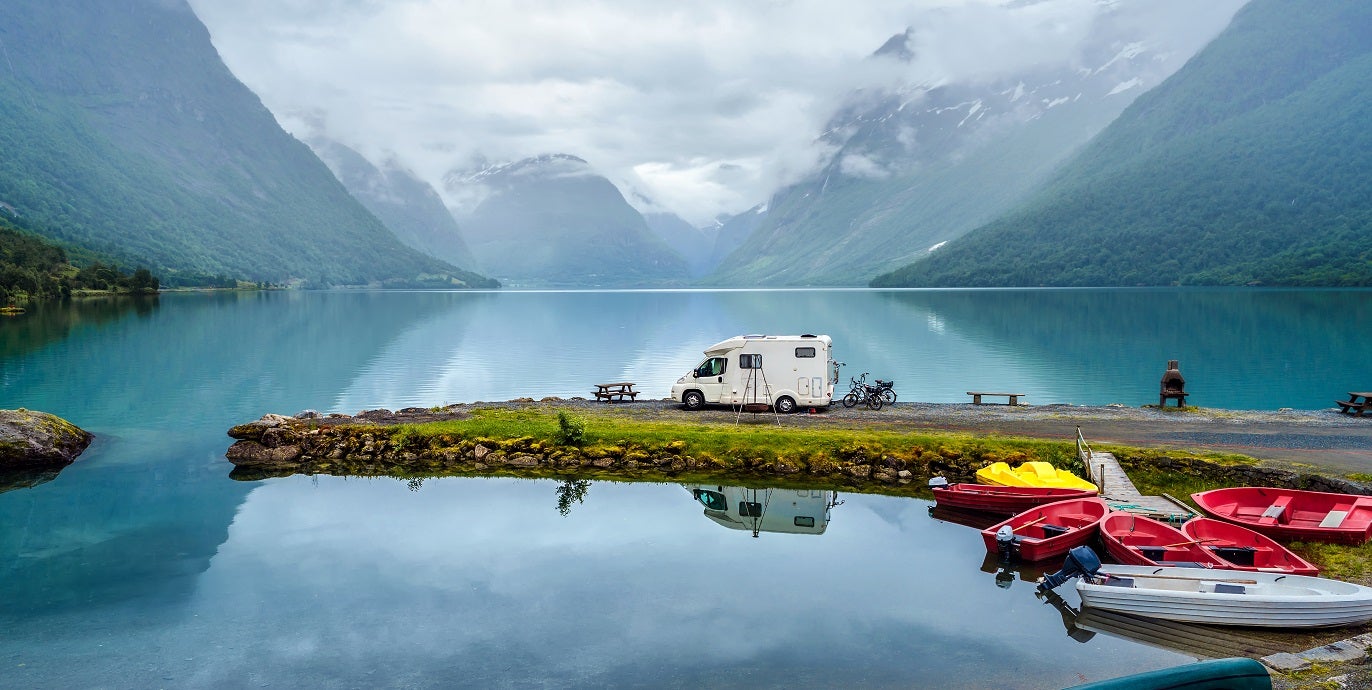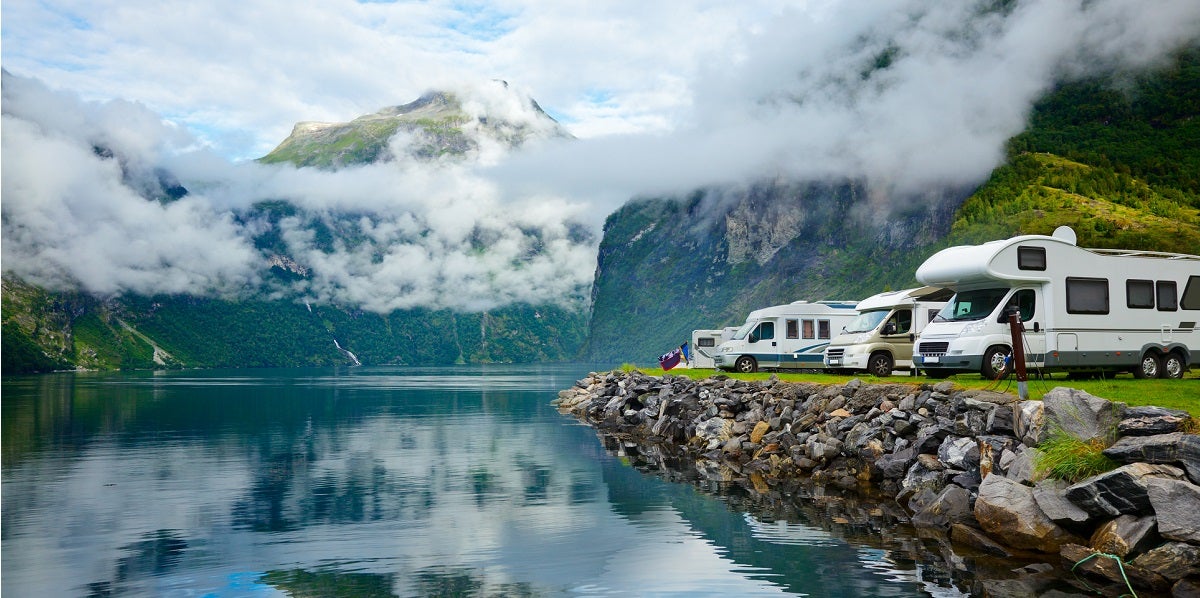
Our Editors independently research, test, and rate what we feel are the best products. We use affiliate links and may receive a small commission on purchases.
If you aren’t fond of sleeping in a tent, but you still want to experience the great outdoors, RV camping may be the perfect solution. With an RV, you can spend time in nature and still enjoy creature comforts like a fridge and running water. With that in mind, give RV camping a try. Here’s our RV setup checklist with a few essential tips to help prepare you for your first trip.
RV Setup Checklist
1. Research Campgrounds
Before heading out or making a packing list, it’s best to research campgrounds, especially if you plan to camp in several different spots during your trip. A brief web search will reveal a number of different site options. You’ll most likely have to choose between an RV resort, park or campground. Each one offers a different experience for you and your family.
RV resorts are well-maintained and offer premium amenities and a luxurious experience close to civilization. Naturally, parking your RV on one of these sites will be the most expensive option. Parks, on the other hand, are less classy.
However, they still typically come with a playground or clubhouse with basic amenities. If you’re looking for something more rustic, a campground should be your go-to. These spots usually come with a fire pit and communal bathrooms, making them the most basic option.
2. Reserve Your Spot
Once you determine where you’d like to park your RV, make reservations to secure your spot. This step is especially important if you’re looking to camp in a popular area or during a peak season.
Usually, you can make reservations online and even view the exact spot in which you’ll park. However, some are a first-come-first-serve type of arrangement. In this case, you’ll want to show up to the site early and set up camp before anyone else.
If you aren’t able to make a reservation and arrive at a campsite with no vacant spots, don’t worry! The local Walmart may allow you to park in their lot overnight. Ask the store manager for permission and make sure there are no ordinances against staying for an extended period. Otherwise, you should be able to stay for a night or two.
3. Practice Driving and Parking
If you’ve never driven an RV or only drive yours once or twice a year, it’s a good idea to practice a bit before heading out on your trip.
Take your big rig for a drive around the neighborhood and down a local highway to brush up on your RV driving skills. Try finding some hills to drive up and down. Additionally, practice backing it up to see how difficult this might be in the future.
Once you arrive at your campsite, you’ll also have to park your RV, so don’t forget to practice doing that as well. It’s likely your site will be somewhat uneven, in which case you’ll also have to level your RV.
Doing so will ensure your refrigerator works properly and that your motorhome doesn’t sway when you move about inside it. Use leveling blocks or ramps and a small bubble level if your RV doesn’t have a built-in self-leveling system. Don’t forget a backup camera so you don’t run over something!

4. Keep Bugs Out
Whether you’ve kept your RV in a covered storage area or parked it out in your backyard, you’ll likely have a few critters to deal with after a long winter.
Before packing your RV full of essentials and setting out, it’s best to inspect the inside and outside. If there are bugs in your RV, try sprinkling a repellant powder around. Place ant traps under the sink and in corners and introduce citrus scents to ward off spiders.
Once you hit the road, be sure to keep your RV clean to prevent more bugs from entering and making their home there. Regular cleaning will also keep nasty microscopic bugs — otherwise known as germs — out.
This step is crucial as the country battles the COVID-19 pandemic. Provide a safe space for your family by thoroughly cleaning and disinfecting your RV before camping.
5. Test Systems and Weigh Your RV
Make sure your RV is ready to go when you are by testing its systems to ensure they function correctly. Inspect the engine, generator, air conditioner, appliances, brakes, lights and all other essential systems before you leave.
If you are not going to be in an RV park with an electrical hookup, consider using solar panels with an inverter to provide electricity. If you plan on using the RV park’s electrical hookup, be sure to bring a surge protector so there is no damage to your RV electrical systems or appliances.
It’s not uncommon for a water line to burst, for instance, or the air conditioner to malfunction. Create a checklist to ensure you don’t overlook anything. If a component isn’t functioning properly, take your RV to a mechanic.
Additionally, you should weigh your RV at a weigh station to make sure it doesn’t exceed the vehicle weight limit. If it’s too heavy, it’ll wear down the tires quicker and can increase your chances of getting a flat during your trip. Plus, a weighty RV will put extra strain on your engine.
6. Pack the Essentials
While RV camping does allow you to pack more items than traditional tent camping or backpacking, you should still try to pack light. Otherwise, your RV will feel claustrophobic, and you’ll spend most of the trip searching through mounds of stuff. Besides, your RV will be your home for the duration of your journey, and you want to feel comfortable, not stifled.
Create a cozy environment by packing only what you need. Create a separate RV setup checklist based on the activities you plan to undertake while camping, and be sure to add a first-aid kit with items like antibiotic ointment, bandages, ice packs, hand sanitizer and more.
You should also pack an generator, house battery, a water hose and a sewer hose if you plan to use a hook up at your site. Pack heavier items near the floor to prevent swaying and lessen the chance of them falling out of cabinets and overhead storage areas.
7. Tow the Easy Way
If you’re planning to tow your car and can do so with all four wheels on the ground, use a tow bar instead of a dolly. The bar is easier to handle and hook up.
Plus, you can store it in your RV or car to prevent theft. Be sure to purchase a matching base plate. Bonus points if you get an adjustable one — they’re much more straightforward to use.
If your RV isn’t motorized, you’ll have to tow it using your car. You’ll need to ensure your hitch is on and locked and that your cables are connected and functioning. Bring tools and spare parts along just in case you lose any parts of the hitch or something breaks.
Enjoy Your RV Adventure!
RVing certainly comes with a few extra responsibilities compared to tent camping.And with electric RVs around the corner, things are changing all the time. However, once you understand the basics, camping in your RV will be a cinch. Of course, not everything will go perfectly the first time around — camping is an adventure, after all! Expect to do some troubleshooting and fine-tune your RVing skills. Take notes of what worked and what could have gone better and adjust your RV setup checklist accordingly. When you return, you’ll be more RV-savvy than ever before.
